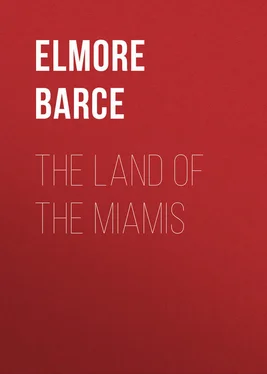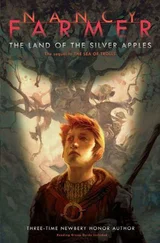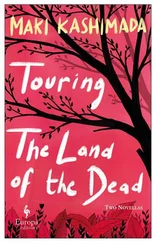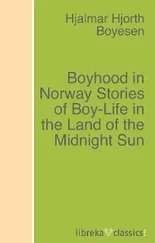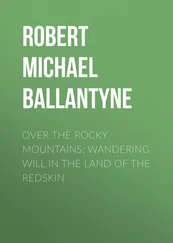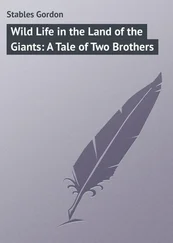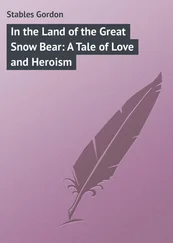Elmore Barce - The Land of the Miamis
Здесь есть возможность читать онлайн «Elmore Barce - The Land of the Miamis» — ознакомительный отрывок электронной книги совершенно бесплатно, а после прочтения отрывка купить полную версию. В некоторых случаях можно слушать аудио, скачать через торрент в формате fb2 и присутствует краткое содержание. ISBN: , Жанр: foreign_antique, foreign_prose, Историческая проза, на английском языке. Описание произведения, (предисловие) а так же отзывы посетителей доступны на портале библиотеки ЛибКат.
- Название:The Land of the Miamis
- Автор:
- Жанр:
- Год:неизвестен
- ISBN:http://www.gutenberg.org/ebooks/30244
- Рейтинг книги:4 / 5. Голосов: 1
-
Избранное:Добавить в избранное
- Отзывы:
-
Ваша оценка:
- 80
- 1
- 2
- 3
- 4
- 5
The Land of the Miamis: краткое содержание, описание и аннотация
Предлагаем к чтению аннотацию, описание, краткое содержание или предисловие (зависит от того, что написал сам автор книги «The Land of the Miamis»). Если вы не нашли необходимую информацию о книге — напишите в комментариях, мы постараемся отыскать её.
The Land of the Miamis — читать онлайн ознакомительный отрывок
Ниже представлен текст книги, разбитый по страницам. Система сохранения места последней прочитанной страницы, позволяет с удобством читать онлайн бесплатно книгу «The Land of the Miamis», без необходимости каждый раз заново искать на чём Вы остановились. Поставьте закладку, и сможете в любой момент перейти на страницу, на которой закончили чтение.
Интервал:
Закладка:
To give a detailed description of the many beautiful rivers, valleys and forests of the northwest at the opening of the last century, would be difficult. It was, as before mentioned, a vast domain, well watered and fertile, and containing some of the best lands in the possession of the federal government. Two rivers, however, assume such historical importance, as to merit a more particular mention. Along their courses two Indian confederacies were organized under the spur of British influence, to oppose the advance of the infant republic of the United States. These two rivers were the Wabash and the Maumee, both leading to the principal center of the fur trade of the northwest, the town of Detroit.
The valley of the Wabash, famed in song and story, and rich in Indian legend, is now filled with fields of corn and prosperous cities. At the close of the Revolution, the great stream swept through an unbroken wilderness of oak, maple and sycamore from its source to the old French settlement of Vincennes. Its bluffs, now adorned with the habitations of a peaceful people, then presented the wild and rugged beauty of pristine days; its terraces, stretching back to the prairies of the north and west, were crowned with forests primaeval; while naked Miamis, Weas and Potawatomi in canoes of bark, rounded its graceful courses to the waters of the Ohio.
For one who has ridden over the hills to the west and south of Purdue University, and viewed the gorgeous panorama of the Wea plain, or who has glimpsed in the perspective the wooded hills of Warren and Vermilion from the bluffs on the eastern side of the river, it is not hard to understand why the red man loved the Wabash. An observer who saw it in the early part of the last century pens this picture: "Its green banks were lined with the richest verdure. Wild flowers intermingled with the tall grass that nodded in the passing breeze. Nature seemed clothed in her bridal robe. Blossoms of the wild plum, hawthorn and red-bud, made the air redolent." Speaking of the summer, he says: "The wide, fertile bottom lands of the Wabash, in many places presented one continuous orchard of wild plum and crab-apple bushes, over-spread with arbors of the different varieties of the woods grape, wild hops and honeysuckle, fantastically wreathed together. One bush, or cluster of bushes, often presenting the crimson plum, the yellow crab-apple, the blue luscious grape, festoons of matured wild hops, mingled with the red berries of the clambering sweet-briar, that bound them all lovingly together."
Through all this wild and luxurious wilderness of vines, grasses and flowers flitted the honey bee, called by the Indians, "the white man's fly," storing his golden burden in the hollow trunks of the trees. While on the march from Vincennes, in the last days of September, 1811, Captain Spier Spencer's Yellow Jackets found three bee trees in an hour and spent the evening in cutting them down. They were rewarded by a find of ten gallons of rich honey.
The great river itself now passed between high precipitous bluffs, crowned with oak, sugar, walnut and hickory, or swept out with long graceful curves into the lowlands and bottoms, receiving at frequent intervals the waters of clear, sparkling springs and brooks that leaped down from rocky gorges and hillsides, or being joined by the currents of some creek or inlet that in its turn swept back through forest, glade and glen to sun-lit groves and meadows of blue grass.
Everywhere the waters of the great stream were clear and pellucid. The plow-share of civilization had not as yet turned up the earth, nor the filth and sewerage of cities been discharged into the current. In places the gravelly bottom could be seen at a great depth and the forms of fishes of great size reposing at ease. "Schools of fishes – salmon, bass, red-horse and pike – swam close along the shore, catching at the bottoms of the red-bud and plum that floated on the surface of the water, which was so clear that myriads of the finny tribe could be seen darting hither and thither amidst the limpid element, turning up their silvery sides as they sped out into deeper water."
The whole valley of the Wabash abounded with deer, and their tiny hoofs wrought foot paths through every hollow and glen. The small prairies bordered with shady groves, the patches of blue-grass, and the sweet waters of the springs, were great attractions. The banks of the Mississinewa, Wild Cat, Pine Creek, Vermilion, and other tributaries, were formerly noted hunting grounds. George Croghan, who described the Wabash as running through "one of the finest countries in the world," mentions the deer as existing in great numbers. On the march of General Harrison's men to Tippecanoe, the killing of deer was an every day occurrence, and at times the frightened animals passed directly in front of the line of march. Raccoons were also very plentiful. On a fur trading expedition conducted by a French trader named La Fountaine, from the old Miamitown (Fort Wayne), in the winter of 1789-90, he succeeded in picking up about eighty deer skins and about five hundred raccoon skins in less than thirty days. He descended the Wabash and "turned into the woods" toward the White River, there bartering with the Indians for their peltries.
As to wild game, the whole valley was abundantly supplied. In the spring time, great numbers of wild ducks, geese and brant were found in all the ponds and marshes; in the woody ground the wild turkey, the pheasant and the quail. At times, the sun was actually darkened by the flight of wild pigeons, while the prairie chicken was found in all the open tracts and grass lands.
The bottom lands of this river, were noted for their fertility. The annual inundations always left a rich deposit of silt. This silt produced excellent maize, potatoes, beans, pumpkins, squashes, cucumbers and melons. These, according to Heckewelder, were important items of the Indian food supply.
To the Indian we are indebted for ash-cake, hoecake, succotash, samp, hominy and many other productions made from the Indian maize. The Miamis of the Wabash, with a favorable climate and a superior soil, produced a famous corn with a finer skin and "a meal much whiter" than that raised by other tribes. How far the cultivation of this cereal had progressed is not now fully appreciated. In the expedition of General James Wilkinson against the Wabash Indians in 1791, he is said to have destroyed over two hundred acres of corn in the milk at Kenapacomaqua, or the Eel river towns, alone, and to have cut down a total of four hundred and thirty acres of corn in the whole campaign. In General Harmar's campaign against Miamitown in the year 1790, nearly twenty thousand bushels of corn in the ear were destroyed. On the next day after the battle of Tippecanoe the dragoons of Harrison's army set fire to the Prophets Town, and burned it to the ground. Judge Isaac Naylor says that they found there large quantities of corn, beans and peas, and General John Tipton relates that the commissary loaded six wagons with corn and "Burnt what was estimated at two thousand bushel."
Of the many other natural advantages of this great valley, much might be written. Wheat and tobacco, the latter of a fine grade, were growing at Vincennes in 1765, when Croghan passed through there. Wild hemp was abundant in the lowlands. The delicious pecan flourished, and walnuts, hazelnuts and hickory nuts were found in great plenty. The sugar maple existed everywhere, and the Indians, who were the original sugar makers of the world, made large quantities of this toothsome article. In addition to this the whole valley was filled with wild fruits and berries, such as blackberries, dewberries, raspberries, gooseberries, and the luscious wild strawberry, that grew everywhere in the open spaces and far out on the bordering prairies.
This sketch of the Wabash and its wonderful possibilities may not be more aptly closed, than by appending hereto the description of Thomas Hutchins, the first geographer of the United States. It appears in his "Topographical Description," and mention is made of the connection of the Wabash by a portage with the waters of Lake Erie; the value of the fur trade at Ouiatenon and Vincennes, and many other points of vital interest.
Читать дальшеИнтервал:
Закладка:
Похожие книги на «The Land of the Miamis»
Представляем Вашему вниманию похожие книги на «The Land of the Miamis» списком для выбора. Мы отобрали схожую по названию и смыслу литературу в надежде предоставить читателям больше вариантов отыскать новые, интересные, ещё непрочитанные произведения.
Обсуждение, отзывы о книге «The Land of the Miamis» и просто собственные мнения читателей. Оставьте ваши комментарии, напишите, что Вы думаете о произведении, его смысле или главных героях. Укажите что конкретно понравилось, а что нет, и почему Вы так считаете.
